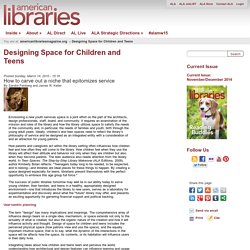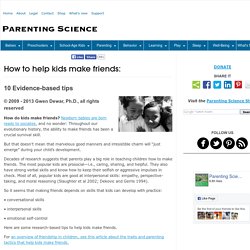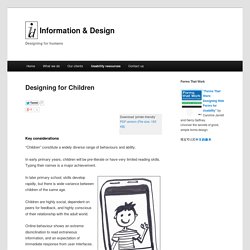

Design Influence Factors. 10 Great Ideas For Designing Kids Rooms. Designing kids rooms can be fun, but it’s always challenging.

What are the keys to creating a pain-free and successful kids room? Planning, planning and more planning! We’ve got you covered with tips on designing a kids room. Designing Space for Children and Teens. Envisioning a new youth services space is a joint effort on the part of the architects, design professionals, staff, board, and community.

It requires an examination of the mission and roles of the library and how the library utilizes space to satisfy the needs of the community and, in particular, the needs of families and youth, birth through the young adult years. Ideally, children’s and teen spaces need to reflect the library’s philosophy of service and be designed as an integrated entity with a consideration of and an attraction for young patrons. 6 Reasons Kids Don't Help Around the House. "So little is expected of kids that ...Their incompetence begets exasperation, which results in still less being asked of them.

" - Elizabeth Kolbert, in “Spoiled Rotten: Why Do Kids Rule the Roost?” In the New Yorker. "My little guy does not like it when I cook or do laundry or do the dishes. Why am I not paying attention to him? But I soon realized that he loves to help. He puts clothes in the washing machine, gathers potatoes to bring to the kitchen, brings me clothes hangers. How to help kids make friends: Evidence-based tips. © 2009 - 2013 Gwen Dewar, Ph.D., all rights reserved How do kids make friends?

Newborn babies are born ready to socialize, and no wonder: Throughout our evolutionary history, the ability to make friends has been a crucial survival skill. But that doesn’t mean that marvelous good manners and irresistible charm will “just emerge” during your child’s development. Decades of research suggests that parents play a big role in teaching children how to make friends. Ergonomics for Children: Ergonomics, design & safety for kids. Interaction Design and Children 2013. Designing for Children. Key considerations “Children” constitute a widely diverse range of behaviours and ability.

In early primary years, children will be pre-literate or have very limited reading skills. Typing their names is a major achievement. In later primary school, skills develop rapidly, but there is wide variance between children of the same age. Children are highly social, dependent on peers for feedback, and highly conscious of their relationship with the adult world.